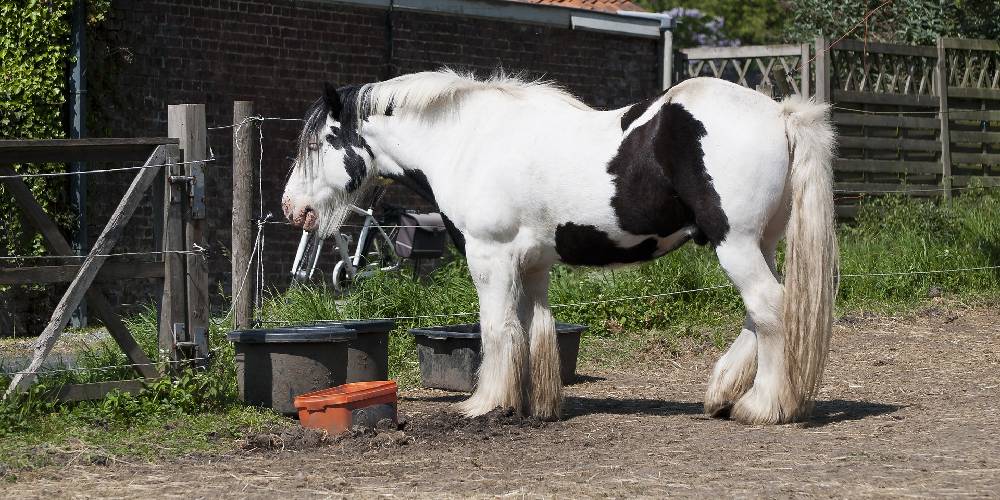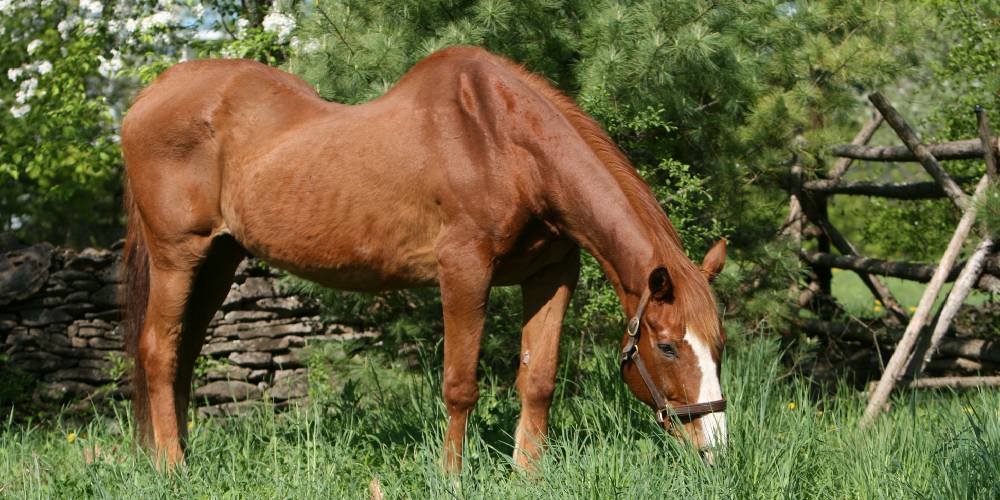Lordosis, more commonly known as swayback, is a fairly common condition seen in a variety of horse breeds. Though lordosis is most commonly seen in the American Saddlebred horse breed, Quarter Horses, Thoroughbreds, Haflingers, and dozens of other horse breeds can also carry this condition.
In simple words, lordosis (or swayback) is a condition seen most commonly in older horses. The appearance of this condition is most prevalent in the American Saddlebred horse breed. Equine lordosis is a curvature of the spine caused by the slackening and weakening of the ligaments in the horse’s back. This weakening of these spinal ligaments causes the inevitable dropping of the spine down towards the earth giving the appearance of very high withers and a sloping top line.
In this post I will discuss the following:
- The main causes for Equine Lordosis
- Breeds that this condition is most commonly seen in
- Can you prevent it?
- Can you fix it once the spine has already curved?
- At what age do horses tend to get lordosis?
- Is Lordosis painful?
- Can you safely ride horses who have this condition?
The Main Causes for Equine Lordosis
There are a few different causes for Equine Lordosis. The five main causes for this condition are the following:
Genetics:
There is a proven link between equine lordosis and genetics. This gene is most commonly seen in the American Saddlebred horse breed, but sometimes can be found in other horse breeds too.
In a study on the genetic cause for equine lordosis, American Saddlebreds were used to examine how many of these swayback Saddlebreds got their condition from their genetics. The study concluded that 17 out of 20 swayback Saddlebred horses used in the study in fact had a genetic link that caused their condition.
While a majority of lordosis cases are not linked to genetics, there are some horses who are genetically more prone to this condition than others.
Pregnancy:
Pregnancy is a fairly big cause for swayback in horses. Broodmares are quite frequently seen becoming lordotic (or swayback) after carrying several foals. This is due to the excessive weight carried in their abdominal cavity during pregnancy. One or two pregnancies are likely not enough to cause a horse to become lordotic unless one of the other causes for lordosis are also at play.
Sometimes pregnancy can be something that will kickstart lordosis to set in. If a horse becomes pregnant and has poor conformation, is older, or has a lordosis-causing gene, the chances that they may become lordotic at some point increase significantly.
Conformation:
The conformation of the horse actually plays a pretty big role in whether or not they will become lordotic at some point in their life. Horses who have a longer back tend to have weaker spines as the ‘supportive pillars’ of the shoulders and hindquarters are further apart.
This means that pregnancy, old age, back strain, or genetics paired with this poor conformation trait will almost definitely cause lordosis to occur. Having the poor conformation trait of a long back can cause lordosis even without being paired with another cause for this condition.
Age:
Old age tends to cause some bodily changes to horses. Sometimes, these changes can cause physical conditions such as lordosis to occur.
As horses age, their structures in their back tend to slacken and wear out over time due to stress or even just gravity taking its toll.
Sometimes older horses will also grow weaker as they age causing their muscles to shrink and sometimes atrophy. This is also a way they can get lordosis as they age.
Back Strain at a Young Age:
Sometimes if horses are put to work or ridden a little too early, it can cause lordosis to occur later in life. This is because the ligaments and muscles in the back of a young horse need time to strengthen and mature enough to carry a rider.
This is often seen in the horse racing industry where young horses are made to carry riders at a very young age as they begin to train for racing.
The above are the 5 main causes for Lordosis in horses, though the following examples are the more ‘exact’ causes for this condition:
- Weakened abdominal muscles
- Weakened back mucles
- Weakened ligaments in the back
- A longer back in a horse
- Carrying a rider that is too heavy and large for them
- Lack of exercise
- Poor genetics
- Not collecting when being ridden (thus allowing muscles to weaken)
- Loss of muscle tone overall
- Cushing’s disease
- Carrying too many foals
- Spinal deformity
Horse Breeds that this Condition is Most Commonly Seen In

There are a number of horse breeds all through the world that are known to have become lordotic or swaybacked. The most common horse breeds to carry this condition are the following:
- American Saddlebred
- Arabian
- American Saddlebred Crosses (any horse with Saddlebred bloodlines)
- Arabian Crosses (any horse with Arabian bloodlines)
- Thoroughbreds
- Morgans
- Tennessee Walking Horses
Though these horses are known to have the highest prevalence for swayback, it doesn’t mean that members of these horse breeds are guaranteed to get or carry this condition.
Can You Prevent Lordosis from Occurring?
There are some things you can do to prevent lordosis from occurring or progressing. Some of the best things you can do to prevent lordosis from starting or progressing are these:
- Feeding grain that helps to keep condition in your horse’s top-line
- Working on collecting your horse when riding
- Encourage your horse to drop their head, relax their spine, and round their back
- Incorporating stretching exercises into your horse’s routine
- Not over breeding your mare
- Not riding your young horse too early
- Keeping your horse’s back/top-line strong
- Making sure your saddle fits appropriately
- Pole work (helps to raise their back, engage the abdomen, and round the top-line)
Can You Reverse Lordosis Once the Spine has Curved?

Unfortunately there is little you can do to reverse the curve of the spine once it has already begun to collapse. What you can do is use the ‘preventative practices’ above to keep your horse’s lordosis from progressing further and further.
At What Age Do Horses Tend to Get Lordosis?

Horses can begin to show signs of that low, sagging back at ages as early as 2 years old! Horses can get swaybacked really at any age, it just all depends on their conformation, genetics, job, and level of exercise.
Swayback, though seen here and there in young horses, is mainly a condition seen in horses that fall in the older age group. The most common ages for horses to begin to get swaybacked fall between 15 and 20. Generally, if the horse is showing signs of swayback around this age, then the condition is likely to progress as they age.
Is Lordosis Painful?
Swayback/Lordosis is not generally a painful condition. The only time that it can be painful for horses is if they are severely swaybacked and are being asked to carry a heavy rider or perform some other task that puts a lot of strain on their backs.
Surprisingly, most swaybacked horses feel no pain or strain at all and can still function and be ridden as a normal healthy horse would
Can You Safely Ride Horses with this Condition?

It really depends! Horses with a severe case of swayback are better off not being ridden or worked because of the severity of their condition. If a horse’s back is bent low enough, it can even be painful or uncomfortable for them to be ridden.
If a horse has a slightly swayed back, like my Arabian Cross Fiire or my Thoroughbred Johnny, they absolutely can still be ridden. Just, when riding a swayback horse, I would make sure their back is cushioned or padded enough so they aren’t uncomfortable during your time riding.
When riding a swayed-back horse, I recommend using a half pad on top of another saddle pad to help pad and cushion their back and make their saddle fit a little bit better. They make some half pads that are designed to be used on swayback or high-withered horses. These work great for giving the horse some extra cushion.
As long as your horse is comfortable, Lordosis is not at all a reason they may need to end their riding career! Keep your horse comfortable and keep on riding!

